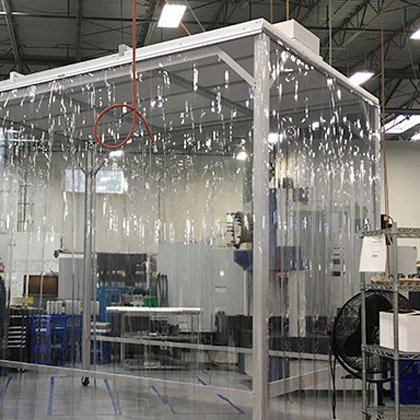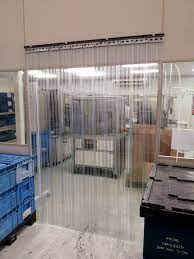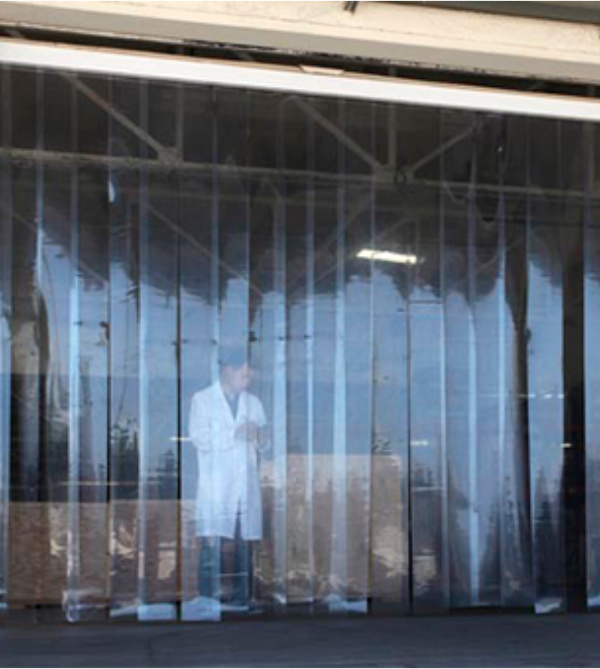Cleanroom curtains are flexible barriers used to isolate controlled environments and maintain cleanroom integrity in pharmaceutical, semiconductor, biotech, and research industries. Typically made from non-particulating vinyl materials, they are installed in modular softwall cleanrooms or used to segment spaces within a larger cleanroom environment.
Unlike rigid walls, cleanroom curtains offer a fast, cost-effective, and reconfigurable solution for containment. Depending on the material, mounting system, and layout, they can support environments rated from ISO Class 5 to ISO Class 8 per ISO 14644-1 standards.

Types of Cleanroom Curtains
Clear Vinyl Panel Curtains
These are large transparent sheets, typically 40–60 mil thick, hung vertically to form the perimeter walls of softwall cleanrooms. They offer full visibility across cleanroom zones and are ideal for basic particulate control in ISO 7–8 environments.
Strip Curtains
Strip curtains are composed of overlapping clear vinyl strips, usually 12 inches wide with 2-inch overlaps on either side. Installed at entrances or pass-throughs, they allow foot or cart traffic while maintaining an air barrier. Ideal for modular setups or temporary labs.
Blackout and Laser-Safe Curtains
Black cleanroom curtains serve two key purposes:
Light Control: Blocking ambient light in photo-sensitive environments (e.g., laser alignment, photolithography).
Laser Safety: Curtains with internal foil layers or laser-attenuating film help block and absorb stray beams per NIOSH guidelines.

How Cleanroom Curtains Work
Curtains serve as soft partitions that restrict airborne particulate transfer between zones while maintaining airflow for proper pressure balancing. Most are suspended from T-grid ceiling frames, curtain rails, or cleanroom-specific aluminum extrusions.
Though they do not seal tightly to the floor (typically a 6-inch gap remains for airflow exhaust), they:
Allow laminar airflow from ceiling-mounted HEPA/ULPA filters
Prevent cross-contamination between adjacent zones
Enable uninterrupted airflow modeling in unidirectional designs
Advantages of Using Cleanroom Curtains
✅ Modularity: Curtains can be added, removed, or rearranged without reconstruction.
✅ Cost-Efficiency: Up to 50–70% lower cost than rigid wall systems.
✅ Fast Installation: Most systems can be deployed in 1–2 days.
✅ Space Flexibility: Easy to reconfigure layouts as production needs evolve.
✅ Visual Clarity: Transparent curtains offer full visibility, improving safety and monitoring.
Limitations and Considerations
Despite their benefits, cleanroom curtains have limitations that must be considered in ISO-critical environments:
⚠️ Cleanability: Vinyl curtains are prone to streaking and scratching, especially with repeated contact or chemical wiping.
⚠️ Durability: Long-term exposure to abrasion or UV may cause fogging, yellowing, or surface cracking.
⚠️ Leakage Risk: Due to floor gaps and movable strips, curtains are less effective in environments requiring high containment (e.g., ISO 5 or biosafety).
Maintenance Tip: Use non-abrasive cleanroom-approved wipes and static-dissipative cleaners to extend curtain lifespan.

Practical Applications by Industry
Pharmaceutical Cleanrooms
Curtains divide formulation, packaging, and QC areas.
Used as airlock barriers in ISO 7–8 compounding rooms.
Semiconductor Labs
Black curtains create optical isolation zones.
Strip curtains serve as ion-free static barriers.
Industrial Assembly Lines
Temporary softwalls for dust-sensitive components.
Quick conversion of warehouse space into ISO 8 environments.
Laser and Optical Research
Laser-safe blackout curtains prevent white light leakage.
Some models are track-mounted and retractable for flexible lab use.
Mounting Systems
Cleanroom curtains can be installed using:
T-grid ceiling mounts (standard in suspended cleanrooms)
Roller tracks for sliding movement (common with blackout curtains)
Velcro or magnetic seals for partial containment
Aluminum frame integration in modular cleanroom kits
Installation must ensure no curtain movement interferes with air velocity, pressure differential, or laminar flow field.
Summary
Cleanroom curtains are a versatile solution for segmenting and expanding cleanroom environments without permanent construction. When used correctly, they help facilities stay agile, reduce costs, and comply with regulatory cleanliness requirements across industries.
| Curtain Type | Best For | ISO Class |
|---|---|---|
| Clear vinyl panel | Softwall cleanroom walls | ISO 7–8 |
| Strip curtains | Entryways, pass-throughs | ISO 7–8 |
| Blackout/laser curtains | Light/laser-sensitive environments | ISO 5–7 (localized) |

